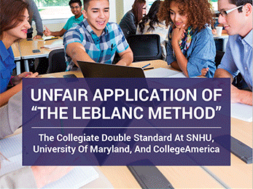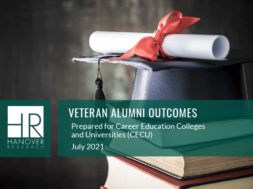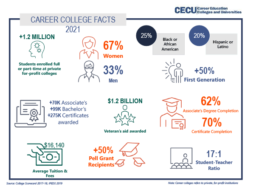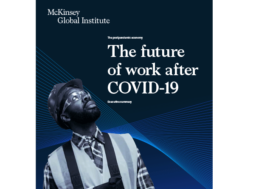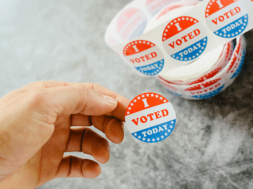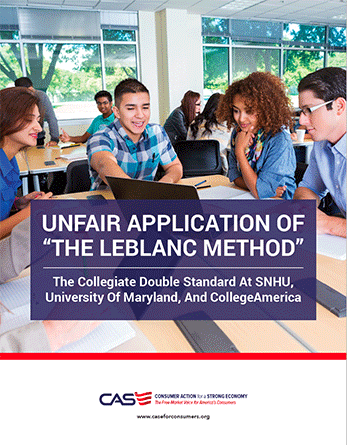
Unfair Application of “The LeBlanc Method”
The Collegiate Double Standard at SNHU, University of Maryland, and CollegeAmerica
By The Consumer Action for a Strong Economy
The challenge
Once the gateway to advancement in America, a degree from a traditional four-year college or university is no longer a guarantee of economic security for its recipient. Many of the highest demand and fastest growth fields do not require a humanities-centric degree.
Skills-based curricula that provide students with an education resulting in certification or credentialing in a high-demand field may provide a surer route to prosperity.
Despite this changing economic reality, much of America’s education establishment encourages and incentivizes students to pursue admittance to and graduation from a four-year college or university. Declining demand and limited opportunities have not curtailed the loans, grants, and promotional efforts intended to lead students to seek enrollment at traditional schools.
Effectively, America’s education establishment behaves like a monopoly, limiting consumer choice, raising the cost of its product, and discouraging alternatives that better meet the needs of the economy – and of students who don’t fit their method.
The solution
Career colleges provide an alternative to traditional four-year colleges and universities. Offering advanced education programs geared toward skill-based fields, they provide opportunities that lead to careers in professions that customarily require certification or credentialing.
Since career colleges are filling a demand traditional four-year colleges and universities have been unable to meet, and since they also attract students who might otherwise not seek an advanced education, you might think the education establishment would not view them as a threat. That assumption couldn’t be more wrong.
Emulating the behavior of a monopoly, the education establishment has employed every tool at its disposal to limit and thwart career colleges. Employing allies in government and the courts, they rely on an unfair double standard to prevent students from seeking the opportunities career colleges offer.
The double standard
This paper considers the significantly differing rules under which schools operate including traditional private schools (Southern New Hampshire University), traditional public schools (University of Maryland Global Campus), and innovative career colleges (CollegeAmerica).
| Southern New Hampshire University | University of Maryland Global Campus | CollegeAmerica | |
| Intense Advertising Oversight & Regulation? | No | No | Yes |
| Unreasonable Outcome Expectations? (GER) | No | No | Yes |
| Receive Government Subsidies? | No | Yes | No |
THE OBSTACLES
Advertising Hypocrisy
Advantages of Traditional Universities
If you know the name of Southern New Hampshire University, or SNHU, you’re not alone. Millions of Americans are now familiar with this private four-year college located off I-93 in Manchester, New Hampshire. As an NCAA Division II school with an on-campus student body of around 4,000, SNHU has more in common with hundreds of universities you’ve probably never heard of than with famous schools like Harvard, USC, or Notre Dame.
Why then, might SNHU be familiar to you? Advertising. SNHU spends millions – in 2018, $139 million – to advertise their online course offerings. As a result, SNHU has become America’s fastest-growing university. At the start of this century, the school had around 8,000 students enrolled in its online and continuing education programs. Today, it has over 80,000.
SNHU President Paul LeBlanc chafes at the suggestion his school might be adopting marketing techniques employed by for-profit schools, but why else would his New Hampshire school have built a multi-million dollar building 2,700 miles away?
As LeBlanc told a gathered crowd in February 2020, “We are excited to officially open our new Southwest Operations Center right here in the heart of Tucson.”
The method he established – aggressively advertising online offerings – is now being emulated by other traditional institutions, including state-supported schools.
The most recent institution to embrace “The LeBlanc Method” is the school formerly known as the University of Maryland University College. Part of the University of Maryland system, the school specializes in online and off-campus education programs. Growing its enrollment to 90,000, the school changed its name to University of Maryland Global Campus, or UMGC, in 2019. And just recently, it appointed a new president who was formerly the President of – you guessed it – Southern New Hampshire University’s Global Campus. To fuel this growth, the University of Maryland – which received $41 million from state taxpayers in FY2019 – pledged to spend half a billion dollars on advertising over six years to complete with SNHU and others.
Different rules for career colleges
Certainly, career colleges can advertise, right? At CollegeAmerica, a career college in Colorado learned, not necessarily.
The Attorney General of Colorado sued the school for advertising the advantages and earning potential of college graduates. As anyone who’s seen an SNHU ad can attest, that’s what colleges advertise. But as a career college, CollegeAmerica was treated differently and held to an entirely different standard by the court.
The most glaring application of this double standard is the charge that CollegeAmerica’s use of Bureau of Labor Statistics wage information mislead consumers in Colorado. But the fact is, many schools rely on BLS data because it is widely viewed as the best data available. Because critical players in business and public policy rely on BLS data to inform their economic decisions, the data must satisfy a number of criteria, including relevance to current social and economic issues, timeliness in reflecting today’s rapidly changing economic conditions, accuracy, consistently high statistical quality, and impartiality in both subject matter and presentation.
Although it’s not perfect, it’s one of the more accurate ways in which universities can quantify the value of a particular degree, and so the use of BLS data is quite common.
A cursory review of several career college websites reveals that CollegeAmerica’s use of these statistics was in line with industry norms. For instance, a student interested in studying animal science at the University of New Hampshire College of Life Sciences and Agriculture can go to their website and access BLS data on the average income for an animal scientist. Similarly, Platt College’s program page for Medical Billing and Coding has a section entitled “How Much do Medical Records and Health Technicians Make?” It answers by linking to the latest BLS data. Finally, the webpage for the University of New Mexico-Los Alamos Environmental Science Associates Program informs prospective students that “lucrative jobs (in Environmental Science) allow you to make a positive impact on our planet” before linking to BLS salary data for life, physical, and social science graduates. Like CollegeAmerica, all of these institutions included qualifying statements informing students that this data is no guarantee of a particular salary. But unlike CollegeAmerica, these schools have somehow avoided regulatory scrutiny.
In fact, career colleges already undergo a rigorous advertising oversight process by their accreditor (which is recognized by the U.S. Department of Education) and state regulators. In the case of CollegeAmerica, their accreditor (ACCSC) and the State of Colorado both frequently reviewed advertising copy without complaint.
Alas, none of this mattered. While the original judge assigned to the case expressed concern bias against career colleges, Denver District Judge Ross Buchanan eventually issued a devastating multi-million dollar ruling against CollegeAmerica, despite the school employing advertising similar to schools like SNHU and UMGC.
The message coming from Judge Buchanan’s bench was clear: career colleges should be treated differently from traditional four-year schools.
Government Regulation
During its eight years in power, the Obama administration ignored problems afflicting traditional four-year colleges and universities. Admission scandals, low graduation rates, massive student debt, and skyrocketing costs were paid little mind. Unsurprisingly, the “cancel culture” enveloping every aspect of campus life at these schools, limiting free speech and prohibiting viewpoints deemed politically incorrect, received zero scrutiny.
Career colleges did not enjoy similar laissez-faire treatment from the federal government. From restrictions placed on funding to holding these institutions to a standard that traditional four-year schools could never meet, the government of the United States did much to hinder the operations of career colleges.
One tool bureaucrats used to discourage career colleges was the Gainful Employment Rule (GER). The GER allows the federal government to police career colleges using an arbitrary standard based on the salaries earned by its graduates. Imagine if a state-funded university were judged by its recent graduates’ salaries, some of whom may be working as baristas or in an entry-level service industry job while trying to find employment in their majors. Traditional universities are not held to such standards of accountability, nor are performance standards ever likely to be used against them.
An even more effective tool employed by the government to limit career colleges is applying different standards for students to obtain funding.
While the government readily approves student loans for those attending traditional four-year schools, those attending career colleges find different standards applied that limit their access to these funds.
Funding available to veterans of the armed services, a demographic aggressively recruited by state-supported UMGC, is particularly singled out by the government. Under a plan promoted by the Biden administration, active-duty military personnel and veterans would see their ability to apply tuition assistance through the GI Bill strictly limited. The scheme would alter the 90-10 rule, which establishes a formula for federal student aid career colleges are permitted to accept.
These new restrictions would limit the education options for veterans, but would also make it financially impossible for some career colleges to continue operating. Traditional four-year schools need not concern themselves with such restrictions.
The way forward
Can private career colleges survive while facing the dual threats of restrictions on advertising and reinvigorated government regulations intended to prevent students from receiving financial assistance? Likely not.
Providing students with prospects for enduring economic opportunity and financial security while building a qualified workforce that makes our nation more competitive in the world economy runs contrary to the interests of an entrenched establishment.
These policies smack of a condescending attitude by our nation’s elites toward those who build, create, and make our nation work. It is an attitude permeating many aspects of our culture, as those who
are not engrained in and indoctrinated by an increasingly prevalent campus culture that insists on conformity not only to particular viewpoints but to a limited number of professional pursuits.
Career colleges are integrally essential to our nation’s prospects for sustainable prosperity in a hyper-competitive world marketplace. While the colleges may suffer from policies intended to diminish their importance or eliminate them entirely, it will be America as a nation that will suffer the consequences.
